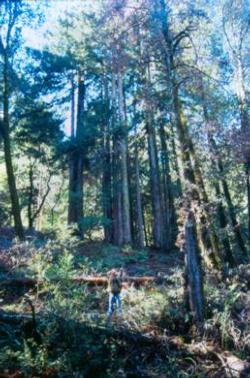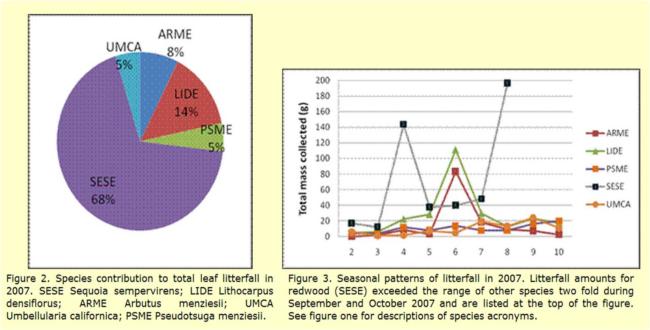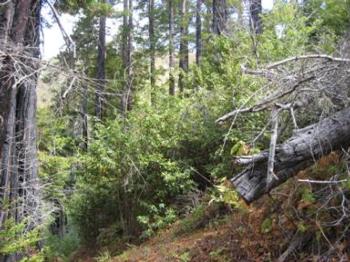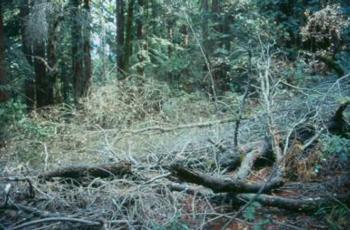Nutrient Cycling
Lead project scientist: Richard Cobb
Forest pathogens may alter ecosystem processes by changing microclimate conditions, selectively removing species, and altering the chemical quality of organic matter inputs via roots, foliage, and wood. Although several studies have demonstrated the potential of forest pathogens to increase rates of soil N cycling and N export in stream water, we lack comprehensive understanding of the ecosystem level consequences of disease outbreak. Identification of the most important mechanisms by which pathogens alter ecosystem processes and the degree of change caused by disease outbreak are prerequisite for modeling disease impacts across forests impacted by sudden oak death or for efforts to predict changes to nutrient cycling in other disease impacted forests.

Figure 1. Sudden Oak Death selectively removes susceptible tanoak but can infect most species common to California redwood forests. These dynamics result in greatly altered microclimate conditions which are conducive to regeneration of shrubs and pathogen tolerant species. Most tolerant specie support foliar infections which may alter the chemistry and subsequent decomposition of litterfall in these forests.
We have initiated a two year study of ecosystem processes in sudden oak death impacted forests with the goal of distinguishing short and long-term redwood ecosystem change resulting from tanoak mortality (Figure 1). Using rates of infection and mortality derived from long-term monitoring our study links community level disease dynamics with nitrogen (N) cycling, litterfall, and litter decomposition. We use these measures to address the following questions:
1. Does foliar infection by Pythophthora ramorum alter the chemical quality, timing, and magnitude of litterfall in infested forests?
2. Does mortality of tanoak in SOD impacted forests increase the absolute amounts of litterfall by slow decomposing species such as redwood or fast decomposing species such as bay laurel?
3. Are SOD impacted forests also experiencing increased rates of N cycling and if so are these changes due to increased forest floor temperature, changes in litterfall quality, or tree mortality?
4. If SOD increases available nitrogen pools, is this response observed in microbial, extractable, or recalcitrant N pools?
5. What is the contribution of large coarse woody debris to total nutrient cycling rates and do these materials act as a source or sink of available N in these forests?
Field measurements designed to address these questions began in winter 2007. Litterfall is collected in passive litter traps at 30 plots in sites located in Sonoma and Marin counties. Three traps with 0.75 m2 surface area are located in each plot and allowed to collect litter over approximately one month periods. For the past 1.5 years, litterfall has been collected monthly and sorted to species, weighed following oven drying at 60C and are currently in the process of being analyzed for total CN concentration.
Redwood (Sequia sempervirens) and tanoak (Lithocarpus densiflorus) litter make up most of the litterfall mass at our study sites (68% and 14% respectively; Figure 2). However, patterns of litterfall differed among dominant species (Figure 3). Tanoak and madrone (Arbutus menzies) litterfall increased during April until peak litterfall in June. Levels for these species then declined. Litterfall for bay laurel (Umbellaria californica)was generally low compared to other species and increased steadily over the observation period. Redwood litterfall often exceeded that of other species by at least two fold and had pronounced peaks during April and reached the highest levels in autumn (August through October). Tanoak litterfall mass was a linear function with positive effects of initial tanoak basal area and negative effects of tanoak mortality. Sudden Oak Death (SOD) significantly reduced the mass of tanoak litterfall and these impacts were proportionate to the amount of mortality which occurred within a particular plot. These results suggest that ecosystem changes in SOD impacted forests will be a function of the amount of change which is possible (ie. initial amounts of tanoak basal area) and severity of disease (rate and extent of mortality). These changes are likely to have cascading impacts on additional ecosystem processes. For example, tanoak litter decomposes slightly more rapidly than redwood litter. However, bay laurel litter decays significantly more rapidly than both tanoak and redwood. Changes in forest structure which increase the dominance of redwood and amounts of redwood litter production will decrease rates of litter decay. In contrast, increases in bay laurel will result in an overall increase in litter decay rates and potentially, increase rates of nutrient cycling and decrease organic matter accumulation in the shallow soils of SOD impacted forests. suggesting that shifts in forest composition to great bay laurel dominance or biomass will increase rates of litter decay at the stand level. Bay laurel plays a key epidemiological role in SOD at the stand level by increasing inoculum levels and pathogen spillover to hosts such as redwood, tanoak, and coast live oak (Quercus agrifolia). Both increased dominance of redwood and bay laurel have been observed in forests impacted by SOD (Figure 4). The amount of increase of each species is a function of the initial biomass, this pattern likely reflects subtle niche suitability across edaphic conditions commonly found in California redwood forests.

Woody debris can increase dramatically in SOD impacted forests. In order to address the role of large woody debris in the recent fires in SOD impacted forests of Big Sur and the growing concern over fuel loads in more northern forests we have begun a comprehensive survey of coarse woody debris (CWD) across a network of redwood dominated plots established by Patricia Maloney (see Maloney et al. 2006). CWD is an important part of the organic matter cycle, wildlife habitat, and can determine the intensity of wildfire (sensu Harmon et al. 1986). Our survey begain in fall 2007 and expected completion date is fall 2008. We measured every piece of large woody debris greater than 1m long and 10cm in diameter in each 500 m2 study plot. Logs were assessed for length, diameter on the large and small ends, and assigned a decay class. We will use these data in conjunction with measurements of snag recruitment (dead standing trees) to estimate input rates and dynamics of CWD across the range of disease impacted forests. Key questions include:
- What is the rate and amount of CWD input in disease impacted forests?
- Can rates of wood decay be estimated for logs and snags? If so, how should dead wood be managed in disease impacted forests to minimize fuel loads as quickly as possible?
Understanding the relationship between disease and fuel loads is fundamental to predicting locations that will develop dangerous fuel loads. Identifying sites with large amounts of woody debris accumulation is also critical to focusing limited funds for management of SOD impacts. A critical management question is how to deal with dead wood generated by SOD. Do dead trees decay faster as snags or logs? Do logs decay more rapidly when trees died and remained standing or when trees fall and develop contact with saprophytic organisms present in the forest floor?
 Figure 4Figure 4. Prolific regeneration of California bay laurel following tanoak mortality. Bay laurel can regenerate prolifically in stands with canopy disturbance.
Figure 4Figure 4. Prolific regeneration of California bay laurel following tanoak mortality. Bay laurel can regenerate prolifically in stands with canopy disturbance.

Our initial data collection shows that tanoak dominates the CWD pool at disease impacted sites and further, that the amount of wood that accumulates on the forest floor is a linear function of tanoak mortality (Figure 5). Tanoak dominated sites have the greatest potential to increase fire danger and fuels management in coastal California may be best applied in upland sites with tanoak and bay laurel species mixes. Fuels management may benefit from host removal pre-disease establishment in order to stretch fuel accumulation and opportunity for decay over a longer time period. Fuels management in SOD impacted forests may also benefit from manipulations which encourage regeneration of redwood and douglas fir (Pseudotsuga menziesii) as these species play a limited role in the epidemiology of SOD and increasing their density would reduce overall Phytophthora ramorum inoculum loads. In many areas, high tanoak density is a consequence of past redwood harvesting and restoration programs could be readily tailored to include the objectives of reduced fuels.
 Figure 5Figure 5. Accumulation of coarse woody debris in forests impacted by sudden oak death. Recent wildfires in SOD impacted forests such as many in the Big Sur region have increased concern over fire danger in these disease impacted systems.
Figure 5Figure 5. Accumulation of coarse woody debris in forests impacted by sudden oak death. Recent wildfires in SOD impacted forests such as many in the Big Sur region have increased concern over fire danger in these disease impacted systems.

Related literature:
Berg, B. and McClaugherty, C. 2007. Plant Litter–Decomposition, Humus Formation, Carbon Sequestration. 2nd edition Springer Verlag, New York 336 pp.
Gartner, T. B., and Z. G. Cardon. 2004. Decomposition dynamics in mixed-species leaf litter. Oikos. 104:230–246
Maloney PE, Lynch S, Kane S, Jensen CE, Rizzo DM. Establishment of an emerging generalist pathogen in redwood forest communities. J. of Ecology 93: 899-905.
